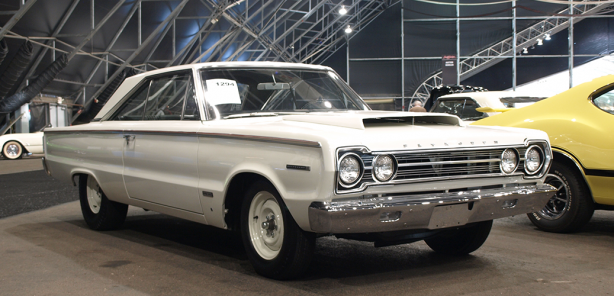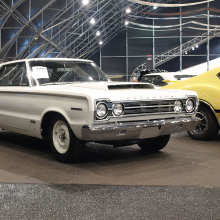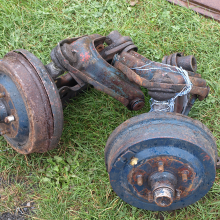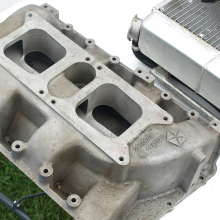Stripped for Success
The 1967 WO23 Lightweight Street HEMI® Coronet
To fully appreciate the strategy behind the 1967 WO23 lightweight Street HEMI® Coronet, we have to begin with the brakes. When Dodge unleashed the A102 Street HEMI option in 1966, the utmost in severe-duty brake equipment was baked into the deal. That meant Street HEMI buyers got 11-inch drum brakes right off the WK41 Police Pursuit Coronet. They assured plenty of “whoa” to match the 425horsepower HEMI’s “go”. It was the correct strategy for a road-going, general purpose muscle car.
But for the strip-oriented WO23 lightweight Street HEMI Coronet hardtop (and its sibling RO23 lightweight Street HEMI Belvedere II hardtop from Plymouth), Dodge equipped the WO23 with 10-inch front drums and 11-inch rear drums. Yes, the front drums were smaller than the rear drums, a reversal of typical procedure based on the fact the front brakes generally cope with 70-percent of total braking duty.
To a road racer, it might seem a recipe for uneven brake bias in the twisties, but to the mind of a drag racer, it made perfect sense. The lighter 10-inchers up front reduced spring and un-sprung mass by over 10 pounds, while the heavier 11s out back were perfectly placed atop the contact patch of the rear slicks where they helped to better force the tread into the strip. Now it makes sense, right? After all, the WO23 Package Car was designed specifically for NHRA A/Stock drag racing where cars had to carry 7.00 to 8.69 “advertised” pounds per “advertised” horsepower.
To keep the package as light as possible, while the standard Street HEMI front suspension was essentially a copy of the Coronet Police Pursuit setup, the WO23 lightweight Street HEMI Coronet was essentially base-level Slant Six stuff. Thinner 0.88-inch torsion bars replaced the Street HEMI’s 0.92-inchers and the rise-inhibiting front anti-roll bar was eliminated. And following Max Wedge (1963-64 lightweight models) and Race HEMI precedent, a huge 90-pound Mopar® Super Stock battery made its home in the trunk, helping to plant the (owner-supplied) slicks. Likewise, the menacing broad hood scoop that had become synonymous with factory Race HEMIs was included – with a straightened rear edge to suit the 1967 Coronet hood’s cut line. As always, the scoop was fully functional and ducted fresh air to the dual carburetors below.
Out back, 4-speed models got the indestructible Dana 60 while the cushioned up-shifts provided by the 727 TorqueFlite allowed use of the lighter (by 50 pounds) 8-3/4 axle in clutch-less applications. Both axles were fitted with 4.88 gears and standard issue Sure Grip differentials. Inside, base Coronet 440 bench seat interiors prevailed with thinner carpeting and zero sound deadeners. Transmission choice consisted of a special “slick-shifted”, iron-case A864 4-speed manual or a HEMI-spec 727 TorqueFlite with a full-manual, reverse-pattern valve body.
Under the hood, by 1967, relaxations in the NHRA and AHRA rule books encouraged racers to upgrade their engines for battle with aftermarket parts. So rather than attempt to deliver full-blown racing engines, Dodge supplied the raw material. The WO23s came through with standard 426 Street HEMIs right down to camshaft specs and compression ratio. Aside from the induction setup, the only upgrades were Prestolite transistorized ignition and Hooker headers (supplied in the trunk for owner installation).
About that induction setup, class rules mandated continued use of the Street HEMI’s in-line dual quad intake manifold. The mighty Race HEMI cross ram was off limits without moving into Modified Production classes. To improve performance of this street-oriented manifold design, noted Mopar Super Stock racer “Akron” Arlen Vanke was contracted to eliminate the individual bores below each carburetor throttle blade. This improved flow and increased plenum volume. Also provided to WO23s were special Carter AFB carburetors specially massaged to look like 625-cfm Street HEMI units, but with larger 1-11/16 throttle bores to bump flow to 750 cfm.
In the end, a mere 55 Dodge WO23 Coronets (and 55 Plymouth RO23 Belvederes) were built for the 1967 racing season. Interestingly, records show that every one of them (Plymouth included) was built at Chrysler’s Lynch Road plant on Sunday, February 12, 1967. The decision to build them on Sunday was made to take advantage of the less frantic weekend pace. This allowed extra time for workers to slow down and make sure the right components were selected and installed. All legitimate WO23 Coronets (and RO23 Belvedere IIs) must show a February 12th production date on the fender-mounted trim tag.
The RO23 fleet mostly battled in the NHRA’s B/Stock category (8.70 to 9.49 advertised pounds per advertised horsepower) against 396 Camaro, 427 Fairlane and other HEMIs with respectable mid-11 second time slips. They may be one of the more “tame” of the HEMI Package Cars, but modern collectors still value them well above their 1967 Street HEMI Coronet R/T and Belvedere GTX cousins.
Visit past Packaged Performance Installments:
- Packaged Performance
- Straight-Line Thinking (1962-1964 Max Wedge)
- Less is More(1964-65 330 and Coronet Race HEMI)
- Junior Dynamite (1966 D-Dart)
Future Packaged Performance Installments:
- Dodge Drops the A-Bomb (1968 LO23 HEMI Dart)
- The Ultimate Big-Cube-Engine-In-Small-Car Offering (1969 Dart 440)
- “They Are Not Race Cars” (1969 ½ Super Bee Six Pack)
- NOT For Street Use (2009 Dodge challenger LC22R Drag Pak)
- Sneak Peak (1320 Concept)







0 Comments